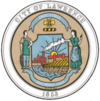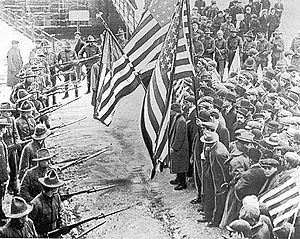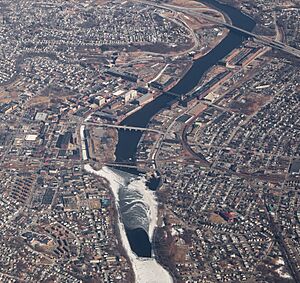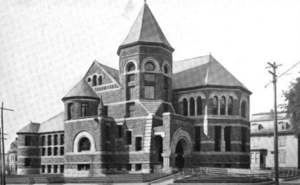Lawrence, Massachusetts facts for kids
Quick facts for kids
Lawrence, Massachusetts
|
|||
|---|---|---|---|
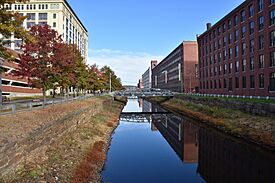
North Canal
|
|||
|
|||
| Motto(s):
Industria (Latin)
"Industry" |
|||
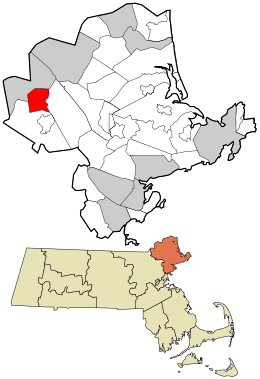
Location in Essex County, Massachusetts.
|
|||
| Country | United States | ||
| State | Massachusetts | ||
| County | Essex | ||
| Region | New England | ||
| Settled | 1655 | ||
| Incorporated | 1847 | ||
| Incorporated (city) | 1853 | ||
| Founded by | Essex Company | ||
| Named for | Abbott Lawrence | ||
| Government | |||
| • Type | Mayor–council | ||
| Area | |||
| • Total | 7.43 sq mi (19.24 km2) | ||
| • Land | 6.93 sq mi (17.95 km2) | ||
| • Water | 0.50 sq mi (1.29 km2) | ||
| Elevation | 16 ft (5 m) | ||
| Population
(2020)
|
|||
| • Total | 89,143 | ||
| • Density | 12,863.35/sq mi (4,966.73/km2) | ||
| Time zone | UTC−5 (Eastern) | ||
| • Summer (DST) | UTC−4 (EDST) | ||
| ZIP Codes |
01840–01843
|
||
| Area code(s) | 351/978 | ||
| FIPS code | 25-34550 | ||
Lawrence is a city in Essex County, Massachusetts, United States. It sits along the Merrimack River. In 2020, about 89,143 people lived there. Nearby towns include Methuen, Andover, and North Andover. Lawrence used to be a county seat for Essex County.
The city makes many products like electronics, fabrics, shoes, and paper. Famous people from Lawrence include poet Robert Frost, composer Leonard Bernstein, and singer Robert Goulet.
Contents
- History of Lawrence
- Geography
- Population and People
- Economy
- Arts and Culture
- Education
- Media
- City Services and Transportation
- Notable People
- See also
History of Lawrence
Early History and Native Americans
Long ago, Native Americans lived along the Merrimack River. They farmed and made tools here for thousands of years. When Europeans first arrived in the 1600s, groups like the Pennacook and Massachusett lived in the area.
English settlers bought the land that would become Lawrence in the 1640s.
How Lawrence Became a Textile City
Europeans first settled nearby in 1640. The land that is now Lawrence was once part of Methuen and Andover. In 1844, a group of businessmen formed the Essex Company. They bought land along the Merrimack River. Their goal was to use the river's power for factories.
Construction of the Great Stone Dam began in 1845. This dam helped control the river's water. The Essex Company sold water power to large factories like the Arlington Mills. Canals were dug on both sides of the river to bring water to the mills. Many Irish workers helped build these canals and mills. The work was often dangerous.
In 1847, the community became a town called Lawrence, named after businessman Abbott Lawrence. It became a city in 1853.
The Bread and Roses Strike of 1912
Working in the mills was hard and sometimes unsafe. In 1860, the Pemberton Mill collapsed, killing 145 workers. As many immigrants came to the United States, Lawrence grew with workers from many countries.
In 1912, workers protested the poor conditions. This protest is known as the Bread and Roses Strike. It was a very important labor struggle in American history. Workers, including many women and people from different countries, stood together.
During the strike, hundreds of hungry children of the strikers were sent to live with families in other states. This brought attention to the workers' struggles. The mill owners eventually agreed to give workers raises. However, over time, many mill owners moved their factories to other parts of the country.
Lawrence After World War II
Lawrence was a major center for processing wool. But this industry started to decline in the 1950s. The city's population dropped from over 80,000 in 1950 to about 64,000 in 1980.
City Changes and Renewal
Like many older cities, Lawrence tried to rebuild and improve itself. In the 1960s and 1970s, parts of downtown Lawrence were torn down. They were replaced with parking lots and a mall. Old movie theaters and the main post office were also removed. This changed the look of the city center.
More recently, the city has focused on saving old buildings. Many former mill buildings along the Merrimack River are being turned into new businesses, homes, and schools.
Recent Events
In the late 1960s, many immigrants from the Dominican Republic and Puerto Rico began moving to Lawrence. They were drawn by affordable housing and the city's history of welcoming immigrants.
On September 13, 2018, there were many gas explosions and fires in Lawrence and nearby towns. One person died, and many had to leave their homes.
Timeline of Lawrence
- 1845 – Essex Company starts building the dam and canal on the Merrimack River.
- 1847 – The town of Lawrence is officially created. It is named after Abbott Lawrence.
- 1848 – The Great Stone Dam is built across the Merrimack River.
- 1853 – Lawrence becomes a city.
- 1860 – The Pemberton Mill collapses, killing 145 workers.
- 1912 – The famous 1912 Lawrence Textile Strike (also called the "Bread and Roses Strike") takes place.
- 1995 – The Malden Mills factory burns down. The CEO, Aaron Feuerstein, keeps paying workers while it is rebuilt.
- 2018 – A series of gas explosions and fires happen in Lawrence and nearby towns.
Immigrant Communities in Lawrence
Lawrence is known as the "Immigrant City" because many different groups of people have made it their home. Most came during big waves of immigration from Europe before the 1920s.
Early Immigrants (1845–1920)
Lawrence welcomed many immigrants from Europe. The first large groups were the Irish in 1845, followed by Germans after 1848. Swedes and French Canadians also arrived from the 1850s onwards. After 1900, more people came from Italy and Eastern Europe, including Jewish people from Russia and Poland.
By 1920, many ethnic groups had social clubs in the city. But churches were often the most important places for community life. Lawrence has many churches, which show where different immigrant groups lived.
Germans
The first large German community came after 1848. A bigger group arrived after 1871, seeking work in the mills. Germans had many social clubs, choirs, and churches in Lawrence.
Italians
Italian immigrants formed Holy Rosary Parish in 1905. They started a special procession in 1923 for three Catholic saints: Saint Alfio, Saint Filadelfo, and Saint Cirino. This "Feast of Three Saints" festival still happens in Lawrence every Labor Day weekend.
French Canadians
French Canadians were the second largest immigrant group. They built their first church, St. Anne's, in 1872. Many came from farms in Quebec, Canada, looking for jobs in industrial towns.
Lebanese ("Syrians")
Many Arabic-speaking people from what is now Lebanon settled in Lawrence. Most were Maronite Christian. They built churches like St. Anthony's Maronite Church in 1903.
Jews
Jewish merchants opened many shops in Lawrence. The fanciest men's clothing store, Kap's, was founded by Elias Kapelson from Lithuania. Jewish people built synagogues and a Jewish Community Center.
Polish
The Polish community grew in Lawrence, especially after 1900. By 1905, they built the Holy Trinity Church. Many Poles worked in the wool and textile mills.
Lithuanians
Lawrence had a good-sized Lithuanian community. They formed both Lithuanian Catholic and Lithuanian National Catholic churches.
English
Many English laborers came to Lawrence after 1880. They found jobs in the textile mills, often getting better positions because they spoke English.
Yankee Farmers
Not all new residents were from other countries. Some were American farmers from New England. They moved to Lawrence when farming became harder due to competition from larger farms in the Midwest.
New Immigrants (1970 to Present)
After the 1920s, fewer immigrants came to Lawrence for many years. But in the 1960s, foreign immigration increased again. Many new arrivals came from Cuba, Puerto Rico, the Dominican Republic, and other Latin American countries. People from Southeast Asia, especially Vietnam, also settled here.
Today, many Catholic churches in Lawrence hold services in different languages. For example, St. Patrick's Church offers Spanish masses. This shows how diverse Lawrence has become.
Geography
Lawrence covers about 7.4 square miles. Most of it is land, with some water. The city is on both sides of the Merrimack River. It's about 26 miles upstream from the Atlantic Ocean.
Besides the Merrimack River, other rivers include the Spicket River and the Shawsheen River. The city has two power canals that once powered the mills. These canals get water from the Great Stone Dam. When it was built in the 1840s, it was the largest dam in the world.
The highest point in Lawrence is Tower Hill, which is about 240 feet above sea level. Den Rock Park is a wooded area that offers places for nature walks and rock climbing.
Climate
Lawrence has a humid continental climate. This means it has warm summers and cold, snowy winters.
| Climate data for Lawrence, Massachusetts (1991–2020 normals, extremes 1893–present) | |||||||||||||
|---|---|---|---|---|---|---|---|---|---|---|---|---|---|
| Month | Jan | Feb | Mar | Apr | May | Jun | Jul | Aug | Sep | Oct | Nov | Dec | Year |
| Record high °F (°C) | 70 (21) |
76 (24) |
88 (31) |
93 (34) |
98 (37) |
101 (38) |
106 (41) |
101 (38) |
100 (38) |
89 (32) |
81 (27) |
75 (24) |
106 (41) |
| Mean maximum °F (°C) | 57.9 (14.4) |
58.6 (14.8) |
67.0 (19.4) |
80.8 (27.1) |
87.5 (30.8) |
91.8 (33.2) |
93.5 (34.2) |
92.2 (33.4) |
88.6 (31.4) |
78.8 (26.0) |
70.3 (21.3) |
61.2 (16.2) |
95.3 (35.2) |
| Mean daily maximum °F (°C) | 35.1 (1.7) |
37.3 (2.9) |
44.9 (7.2) |
57.2 (14.0) |
68.0 (20.0) |
77.3 (25.2) |
82.9 (28.3) |
81.4 (27.4) |
74.2 (23.4) |
61.8 (16.6) |
50.8 (10.4) |
40.6 (4.8) |
59.3 (15.2) |
| Daily mean °F (°C) | 27.3 (−2.6) |
29.4 (−1.4) |
37.3 (2.9) |
48.6 (9.2) |
58.9 (14.9) |
68.2 (20.1) |
73.8 (23.2) |
72.6 (22.6) |
65.3 (18.5) |
53.1 (11.7) |
42.8 (6.0) |
33.4 (0.8) |
50.9 (10.5) |
| Mean daily minimum °F (°C) | 19.6 (−6.9) |
21.4 (−5.9) |
29.7 (−1.3) |
40.0 (4.4) |
49.8 (9.9) |
59.2 (15.1) |
64.8 (18.2) |
63.8 (17.7) |
56.3 (13.5) |
44.4 (6.9) |
34.8 (1.6) |
26.2 (−3.2) |
42.5 (5.8) |
| Mean minimum °F (°C) | 0.0 (−17.8) |
3.4 (−15.9) |
10.6 (−11.9) |
26.9 (−2.8) |
37.0 (2.8) |
46.5 (8.1) |
54.2 (12.3) |
52.4 (11.3) |
40.7 (4.8) |
30.1 (−1.1) |
19.6 (−6.9) |
8.6 (−13.0) |
−2.9 (−19.4) |
| Record low °F (°C) | −23 (−31) |
−25 (−32) |
−6 (−21) |
9 (−13) |
16 (−9) |
35 (2) |
43 (6) |
37 (3) |
28 (−2) |
19 (−7) |
4 (−16) |
−20 (−29) |
−25 (−32) |
| Average precipitation inches (mm) | 4.17 (106) |
3.77 (96) |
4.68 (119) |
4.15 (105) |
3.81 (97) |
4.11 (104) |
3.66 (93) |
3.72 (94) |
3.90 (99) |
4.69 (119) |
3.85 (98) |
4.74 (120) |
49.25 (1,250) |
| Average precipitation days (≥ 0.01 in) | 11.3 | 8.7 | 9.6 | 9.9 | 11.9 | 11.1 | 9.2 | 8.9 | 8.6 | 9.9 | 9.6 | 10.0 | 118.7 |
| Source 1: NOAA | |||||||||||||
| Source 2: National Weather Service | |||||||||||||
Population and People
| Historical population | ||
|---|---|---|
| Year | Pop. | ±% |
| 1850 | 8,282 | — |
| 1860 | 17,639 | +113.0% |
| 1870 | 28,921 | +64.0% |
| 1880 | 39,151 | +35.4% |
| 1890 | 44,654 | +14.1% |
| 1900 | 62,559 | +40.1% |
| 1910 | 85,892 | +37.3% |
| 1920 | 94,270 | +9.8% |
| 1930 | 85,068 | −9.8% |
| 1940 | 84,323 | −0.9% |
| 1950 | 80,536 | −4.5% |
| 1960 | 70,933 | −11.9% |
| 1970 | 66,915 | −5.7% |
| 1980 | 63,175 | −5.6% |
| 1990 | 70,207 | +11.1% |
| 2000 | 72,043 | +2.6% |
| 2010 | 76,377 | +6.0% |
| 2020 | 89,143 | +16.7% |
| 2022 | 87,954 | −1.3% |
| U.S. Decennial Census | ||
Lawrence is a very diverse city. In 2020, most of the people living in Lawrence (about 81.7%) were Hispanic/Latino. Other groups included non-Hispanic White people (12.3%), non-Hispanic Black people (2.3%), and Asian people (1.7%).
Economy
New Balance has a shoe factory in Lawrence. It is one of only five New Balance factories in the United States. Charm Sciences, a company that makes test kits for food safety, also has a lab in Lawrence.
Arts and Culture

Places to Visit
- Bellevue Cemetery
- Campagnone Common
- Essex Art Center
- Great Stone Dam
- High Service Water Tower and Reservoir
- Lawrence Community Works
- Lawrence Experiment Station
- Lawrence Heritage State Park
- Lawrence History Center
- Old Public Library
- Sacred Heart Parish Complex
- Saint Alfio Society (Feast of the Three Saints) - An Italian festival held every Labor Day weekend.
- Semana Hispana (Hispanic Week)
- Veterans Memorial Stadium
Public Library
The Lawrence Public Library opened in 1872. It is a place where everyone can read books and learn.
Education
Public Schools
The city's public schools are managed by Lawrence Public Schools.
High Schools
- Lawrence High School
- High School Learning Center
- Greater Lawrence Technical School – a technical high school for students from Andover, Lawrence, Methuen, and North Andover.
Charter Schools
- Lawrence Family Development Charter School
- Community Day Charter Public School
Private Schools
Elementary Schools
- Bellesini Academy
- Esperanza Academy
- Lawrence Catholic Academy
High Schools
- Central Catholic High School
- Notre Dame Cristo Rey High School
Colleges and Universities
Public Colleges
- Northern Essex Community College
Private Colleges
- Cambridge College
Media
Lawrence has a main newspaper called The Eagle-Tribune. The city also has Rumbo, which is a newspaper in both English and Spanish. There are several radio stations and one TV station in Lawrence.
City Services and Transportation
Transportation
Interstate 495 runs through Lawrence. Other important roads include Route 28 and Route 110. There are several bridges over the Merrimack River in Lawrence.
The city is a hub for the Merrimack Valley Regional Transit Authority's bus service. You can also take the MBTA Commuter Rail from the Lawrence stop to Boston. The Lawrence Municipal Airport is nearby for small planes.
Healthcare
Lawrence General Hospital, founded in 1875, is the main hospital in the city. It serves many people in the area. The city also has the Greater Lawrence Family Health Center.
Notable People
See also
 In Spanish: Lawrence (Massachusetts) para niños
In Spanish: Lawrence (Massachusetts) para niños



